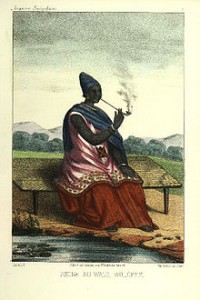I lifted this posed fashion photo off Tumblr from du-style-sinon-rien. It is intended as homage to the African power-broker matriarchs of the island of Gorée during the 18th and 19th centuries. There is a Wiki on the subject (Signares). More on the artist (Fabrice Monteiro) can be found in the usual ways by “searching” — a term which has taken on new meaning of late.
I didn’t realize for a day or so which bells were ringing in my mind until I recalled a piece I published in 1993, back in the days of print, in Nouvelles du Sud #19, «Le regard de la reine: esthétisation du désir politique chez Boubarcar Boris Diop».
In it I shed light on the Senegalese novelist Boubacar Diop’s passing allusion to Ndaté Yallo, Linguère or Queen of the Kingdom of Waalo, the last bastion resisting French hegemony in the region of Senegal.
The royal traditions of the Wolof went back well before the first Portuguese merchants arrived in 1446, when there were matriarchs controlling trade roughly in the same way the signares did later. When the last of the Wolof brak or king died off in 1846, power passed to the “queen” in that system of things: Ndaté Yallo. The French were starting to flex their muscles at the time. In his novel, Boubacar Diop alluded to the myth of Ndaté Yallo to remind his readers that although victors get to write history, for a while at least, they don’t get necessarily to write literature.
Below is a representation of Ndaté Yallo which I had had pasted into that piece. It suggests a congruence of queenly fashion between the Kingdom of Waalo and among the relatively independent shaker-and-mover trading women on Gorée and thereabouts, the signares. Some of that trade was, to put a point on it, in slaves.
Twenty or even ten years ago this visual conflation and the stories behind it would have led me to another 5,000-or-so word academic publication which I would have found pleasure in composing, footnoting and even scrounging up an illustration or two from the archives for.
That was then and this is now. Whatever stray thoughts the juxtaposition of these two images produce is enough for me these days. They have made up the matter of this afternoon, and of the text you are reading.
Yet like any reader, you can pursue either or both or even neither image in your own way and at your own behest. The threads you find will be your own.


